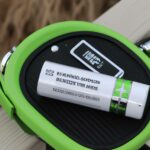Choose the Right Battery Type for Your E-Bike
The type of battery you choose for your e-bike can greatly affect its battery life. The most common types of e-bike batteries include Lithium-ion (Li-ion), Nickel Metal Hydride (NiMH), and Lead-acid. Li-ion batteries have become the most popular choice due to their high energy density and light weight compared to Nickel Metal Hydride and Lead-acid batteries.
- Lithium-ion (Li-ion): These batteries are widely used and have the highest energy density and lowest self-discharge rate compared to other e-bike batteries. They are also lightweight, which is essential when it comes to electric bikes. While they are more expensive than other options, their consistent power output makes them a popular choice for riders around the world.
- Nickel Metal Hydride (NiMH): Nickel Metal Hydride batteries are cheaper than their Lithium-ion counterparts, but less powerful with about half the energy density. They are heavier and dont last as long when compared to Li-ion batteries.
- Lead-acid: Lead-acid batteries are generally slow to charge and discharge, making them a poor choice for cycling around town. They can endure deep discharging/charge cycles and are relatively cheap. Because they are much heavier than the other options and it is hard to install into an E- bike, these are not recommended nowadays as they’re outdated.
When choosing the right battery type for your e-bike, consider factors such as range, weight, cost, and performance. A good Yamaha ESC60Li battery, for example, comes packed with fantastic features that give your e-bike a range of up to 70 miles. Since they are straightforward to install and compatible with multiple e-bike models, Yamaha ESC60Li batteries offer a consistent power supply between rides. This is worth considering as it can dramatically improve your riding experience.
Specific to the battery type advise in the rest of the paragraph such as “Choose a lithium-ion battery“, “Optimized for weight” or even “Opt for no lead-acid or Nickel build options”. Clearing up any misconceptions upfront whilst eliciting confidence in informed decisions by supplying information aimed at grade eight education. You should consider how you’re presenting different types of information, bullet formats, numerical figures in writing meaty guides aimed to beginners or post-beginners about saving an E-bikes battery life
Keep the Battery Temperature Between 20-25°C
Temperature is critical when it comes to maximizing the lifespan and efficiency of your e-bike battery. Just like you store fruits and vegetables in a cool, dry place to prolong their fresh condition, you should also consider storing your battery within an ideal temperature range for long-term battery performance.
The ideal temperature for an e-bike battery is between 20 and 25°C. Anything higher than that could cause the battery to degrade and discharge more quickly. Meanwhile, going too far below the ideal range can cause the e-bike’s battery capacity to get reduced at low temperatures.
If you’re using your e-bike in extreme heat or cold temperatures, your bike should not be left exposed outside under direct sunlight or other extreme conditions. Instead, bring it indoors and in a safe storage space when not in use until a climate-controlled location can be secured. Furthermore, try and avoid long exposure of your battery to high cooling wind, either direct or through cycling.
If you live in a hot climate area, invest in insulated bags specific to storing your bike and battery indoors, with a lid but leaves it open until the battery has cooled sufficiently if the readings go over 25°C. Reduce travel for extended periods, as the bike’s friction and body will produce heat and elevate the battery’s levels expeditiously compounding the hotter external conditions.
Taking precautions with your e-bike battery can prolong its lifespan. Focus on keeping your battery temperature at the optimal range, and a comfortable indoor storage space.
Ensure Your E-Bike Runs on Low Power Mode
If you want to extend the life of your e-bike battery, it is essential to operate it in low power mode. Different manufacturers have different terminologies for this mode, so make sure you check your bike’s manual to find the correct setting.
Using low power mode can have several benefits, one of which includes saving energy and ultimately extending the life of your electric bike battery. When you switch your e-bike onto low power mode, the engine will only use a fraction of the power, which means you will be riding but slowly compared to the full power of the battery. It is the perfect mode to use when cycling through flat terrain or reasonably leveled routes since lower power would be sufficient enough to cover less challenging terrain, thus conserving the bike’s battery.
- When the e-bike runs on high power or top-notch gear, it uses more power than is necessary might discharge the battery quickly, making it die down before you get to your destination.
- The range you get out of each charge depends on several factors, including your type of e-bike, weight, incline, rider style, assist level, etc.Low power mode helps conserve battery and allow you to extend the range by a significant margin.
Avoid using top speed mode at full power mode since this tends to drain battery life much quicker than switching to low or moderate power settings Several other adjustments depend on riding conditions. Once you realize low power mode’s benefits, adjust your settings to go hand-in-hand with whichever terrain you ride.
It is important only to use high power or top equipment when absolutely necessary because otherwise you might lose key torque adjustments, your tires may have trouble maintaining contact with either snowy or slippery roads, your bike might not reach full speed potential, and in the end, you will drain your battery quicker.
Operating your bike according to what the terrain dictates is going to rack up the mileage the battery puts out. Ensuring that your bike uses low power when peddling means that you can potentially go higher distances.
In summary, to get the most battery life out of your e-bike, always operate on low power mode where possible. Paying heed to terrain-specific shortcuts can be considered a wise automotive overture as one stands much more viable with less (battery) capacity drainage.
Pedal as Much as Possible
One simple tactic to save battery life on your e-bike is to pedal as much as you can. Unlike traditional bicycles, e-bikes reduce the amount of effort needed to ride by providing an electric boost. However, even the best e-bike batteries have limited capacity and the amount of available power depends on how much the rider pedals.
The more you pedal, the less work the motor has to do, and that saves the battery. This means that consistency is key. Regardless of whether you are riding in pedal-assist mode or throttle mode, the energy used to pedal is continually being transferred into the motor and enabling a good balance between the human and machine. Try to maintain a constant pedaling mode during your ride instead of relying completely on the electric motor.
- If you are using a full pedal-assist bike, try downshifting if you start to feel the motor struggling on hills so that you can still solve the inclines effectively with your own muscles instead of simply relying on the motor blast through them.
- Like many cyclists, aim to take up cycling in lighter clothing during the warmer months to encourage you to warm up quicker and get a little sweat on, providing more incentive to keep pedaling.
While there’s something compelling about laying back while your bike powers you along with minimal input from you. Remember, pedaling remains key to extending battery life while also improving hand fitness and getting some extra fresh air along the way.
Use Regenerative Braking to Charge the Battery
When it comes to saving battery on your e-bike, regenerative braking is a game changer. Normally when you brake, all of the kinetic energy produced by the bike goes to waste. However, with regenerative braking, that energy is converted into electrical energy and stored in the battery. This means that when you need to brake and slow down, you’re actually filling up your battery.
- What is regenerative braking?
- What are the benefits of regenerative braking?
- How can I use regenerative braking?
- When should I use regenerative braking?
Regenerative braking is a system that captures the kinetic energy produced by your bike when you brake, storing it as electrical energy in the battery. Essentially, it allows you to recharge the battery while you ride.
Aside from charging your battery, regenerative braking also enhances your bike’s efficiency, leading to longer rides on a single charge. It can also help reduce wear and tear on your brake pads, meaning they’ll last longer and cost less to replace.
In general, regenerative braking will activate automatically as you apply your brakes, so there’s no additional effort needed on your part. However, it’s always important to remember that regenerative braking alone won’t fully charge your battery or extend your range on its own, so make sure to use it in conjunction with other battery-saving techniques.
You’ll get the most out of regenerative braking when you’re riding downhill or on flatter terrain, as you’ll be able to coast for longer periods without pedaling, allowing your bike’s energy to be used more efficiently. Avoid using regenerative braking in very hilly or steep terrain, as you’ll likely need more pedaling assistance to stay at a consistent speed.
By using regenerative braking in combination with other battery-saving techniques, you’ll be able to get the most out of your e-bike and prolong the life of your battery. As a bonus, you’ll be doing your part to help the environment by making use of energy that would otherwise go to waste.
Avoid Steep Inclines as Much as Possible
Riding an e-bike uphill can be a lot more challenging than riding on flat surfaces. When you have steep hills in your way, your e-bike’s motor has to work a lot harder to keep up with the demand and this can cause an unnecessary drain on your e-bike battery.
To ensure a longer battery life for your e-bike, avoid steep inclines as much as possible. Find new routes that don’t have any steep slopes or sharp inclines, so you won’t have to put extra pressure on your e-bike’s motor, which will then keep your battery levels intact.
- Choose to ride on roads even if that means having to take a longer route or use a bike planner app if available.
- In case you have no other option than encountering or riding over hills, adjust your assistance level to low power mode (such as eco-mode) which takes up much less energy compared to high cruising speeds.
- Dialling in quality low-resolution gears for such times is also a good idea-this will better facilitate the movement especially getting aerated form standing and pedaling only.
Paying attention to these tips ensures that, even when faced with surroundings full of hills, you still make the most of your e-bike battery. This keeps it running longer, saves you time, and lets you enjoy longer in the open air.
Turn Off the Bike when It is not In Use
One of the easiest ways to conserve battery on your e-bike is simply turning it off when it’s not in use. This might sound intuitive, but it’s surprising how many riders leave their e-bikes switched on unnecessarily. Allowing the bike to sleep still consumes battery power, especially if you have additional features that keep running.
Be sure to get into the habit of consciously switching off the battery each time you’re not cycling. Doing so would help save valuable battery life that you can then use when you need it the most.
- Switching off additional features can be a considerable improvement of the battery time.
You might also want to consider enabling automatic battery sleep mode if available to allow your bike to enter into a more efficient energy-saving phase when not being used for a prolonged period. Further, you can avoid forgetting to switch it off yourself or achieving laptop-like battery saving capability without loss of necessary characteristics such as Bluetooth access to desired devices.
Saving battery power isn’t all about riding, It’s also about how tasks around your e-bike use fluctuating amounts of resources smartly put together.
Use an E-Bike Battery With Maximum Range
The battery is the heart of your e-bike, and finding one with a maximum range is crucial if you want to save battery power. A high-range battery allows you to have longer rides without the need for frequent recharging, which saves you time, money, and also reduces the time needed to enhance your e-bike’s lifespan.
Although a higher-range battery may be more expensive, it could save you money in the long run. Instead of buying a cheaper, lower-range battery, it may be worthwhile investing in a more significant, better-quality battery since you will not require frequent replacements, despite the high cost initially.
A high-range battery provides you with peace of mind when you need to get somewhere urgently without having to worry about recharging your e-bike battery along the-way. The maximum range of the battery that is recommended depends on the type of e-bike you’re using. Your bike manufacturer provides instructions or recommendations as every make varies accordingly.
-
For commuters who require a bit of assistance to get to work or stock up wardrobes whilst reducing the overall carbon footprint, choose a battery pack between 400 and 600Wh.
-
Riders looking forward to cruising with family and friends on light terrain, e-mountain bikers battery must light with a recommended capacity between 500 and 700Wh.
-
For those hardcore cyclists looking for an adrenaline ride, perfect when riding through challenging inclines, consider a high-capacity battery over 700Wh suited perfectly to match the purpose of extended rides through mountainous terrains.
In conclusion, purchasing a high-range battery as per the intended use-guidance between your make type is ideal advice for maximum use-limit overall. Having a battery with large capacity throughout on guiding principles, combined with other tips and benefits outlined in this guide, you conclude with an increased mile range extending riding capabilities at efficient cost-saving when utilizing, ensuring you get the best e-bike battery for your buck.
Use Smaller and Lighter Wheels or Tires
The size and weight of the wheels and tires on your e-bike can have a significant impact on the battery life. When choosing wheels and tires, it is important to consider not only the speed and traction performance but also the energy consumption rate.
In general, smaller and lighter wheels or tires require less energy to move and maintain speed. This means that you will be able to cover more distance on a single charge if you opt for compact-sized wheels. Large or wider tires tend to create more resistance with the ground as well, which requires more power to manoeuvre the bike.
However, it is crucial to strike a balance between the size/weight of the wheels and wear and tear since lightweight tires tend to have a shorter lifespan than denser ones. Always review your manufacturer’s bike specifications to find optimal dimensions for your e-bikes rims and tires.
A smaller-sized tire has another advantage when it comes to reducing battery consumption. A reduced contact patch translates into less surface area-to-road friction caused by the bike’s weight. Traction suffers slightly on slippery or muddy trails though smaller tires generally have firm rubber compounds, maximizing grip. This means you may have difficulty retaining torque because there is lesser load pressed onto the ground.
If you are investing in a new tyre upgrade, consider moving to anti-puncture variants in a lighter design. Along with reducing rolling resistance inputs, puncture protection can give you better acceleration capabilities, which ultimately save energy-thirsty force when starts and avoiding snakebite-type puncture damage that requires added air pressure or overhauls.
The key to saving battery remains to develop driving habits that call for a combination of better control techniques valuable on various terrain types of environment your ride passes through; for example, gaining an ability to adapt riding techniques while maneuvering steep inclines in the right gear,rather than pushing when fatigued.. The aids the motor torque available, enabling the battery to work less.
- Size and Weight are Critical
- A Reduced Contact Patch Has Its Drawbacks
- Upgrading with Anti-Puncture With More Unique Rollers
- Proper Driving Habits Must Coexist
Invest in Good Quality Battery Chargers
When the time comes to charge your e-bike’s battery, you’ll want to make sure that you are doing it in a way that won’t harm the battery’s lifespan. One of the best ways to ensure this is to invest in a good quality battery charger.
Cheap and low-quality battery chargers can potentially damage the battery’s cells as they may overcharge or undercharge them. On the other hand, good quality chargers will keep the battery’s voltage level at a safe and steady rate while charging efficiently.
Your e-bike’s manufacturer might also recommend a certain type of charger to use with your particular bike model, so it’s important to review your owner’s manual carefully.
It’s worth spending some extra money on a good quality battery charger because it will pay off in the long run. You’ll be able to prevent battery damage and prolong its life. Plus, you’ll have peace of mind that your bike is being charged safely and effectively.
- Tip: Only purchase chargers from reputable brands and resellers.
Don’t forget to take care of your charger too. Keep it clean, dry, and away from heat sources or the sun. It’s also best to remove the charger after the battery reaches a full charge and avoid letting the battery drain too much before charging it.
A lot of e-bike riders tend to overlook the importance of investing in a good quality battery charger given all the benefits it can provide. So investing in one could be a crucial step in making sure your e-bike’s battery lasts longer and performs better over time.
Regularly Service Your E-Bike
To ensure your e-bike stays in good condition and conserves battery life, it’s important to regularly service your bike according to the manufacturer’s recommendations. This will help you save battery power on your e-bike and also extend the life of the bike’s battery. Additionally, servicing your bike ensures that all components are functioning correctly and not consuming unnecessary energy.
- Inspect the Battery: Inspect your battery housing for any damage or leaks, and check if connections are loose. Clean the contacts with a dry cloth and watch out for excess corrosion.
- Tighten Bolts and Adjust Brakes: Loose bolts may create drag, which will drain your battery quicker. Ensure that all bolts and nuts are properly tightened. Also, adjust brakes along with noting the order of their mechanistic struggle. Furnishing well tighten will build caliper brake pressure enough to slow or complete stop.
- Lubrication: Lubricate chains to limit friction and excessive wear. Do not risk drowning the bind with oil as necessitate by specific procreator should be considered before lump of oil pour on rubbers.
In summary, regular service of your e-bike helps in saving battery life and ensuring smoother operation. At the same time, it improves energy efficiency and avoids unexpected downtime when it comes to rough traveling on cycle.
Switch Off Additional Features When Not Needed
While using an e-bike, you must be conscious of the additional features that you use during your ride, as it may considerably reduce your battery life. For instance, it’s nice to have light for night rides, but saddle style and position should be your prime consideration as batteries need to power the lights, so turning off your lights during the day can significantly save battery life. Certain features such as the throttle mode, alarm set, and built-in Bluetooth capabilities consume more power, so ensure to switch off features when not in use or simply opt to skip on these add-ons altogether.
One of the biggest causes of drained battery levels is forgetting to turn off the bike when it’s not in use. Always switch off the bike after your ride. This action ensures that the battery doesn’t lose its charge, which ultimately leads to an extended lifespan.
For things that utilize Wi-Fi, GPS location services, or Bluetooth, you must always make sure to stay mobile and forget these functions when you aren’t in need of them. Avoid leaving them activated when you don’t need them, to prevent battery consumption. By switching off your e-bike’s features when not in use, you save a few extra bytes on battery life that could result in being crucial with where you want your energetic lifestyle to take you.
Frequently Asked Questions about E-bike Battery Saving:
- Q: What can I do to save battery on my e-bike?
A: You can try the following: - Choose the Right Battery Type for Your E-Bike
- Keep the Battery Temperature Between 20-25°C
- Ensure Your E-Bike Runs on Low Power Mode
- Pedal as Much as Possible
- Use Regenerative Braking to Charge the Battery
- Avoid Steep Inclines as Much as Possible
- Turn Off the Bike when It is not In Use
- Use an E-Bike Battery With Maximum Range
- Use Smaller and Lighter Wheels or Tires
- Invest in Good Quality Battery Chargers
- Regularly Service your E-Bike
- Switch Off Additional Features When Not Needed
- Q: How do I choose the right battery type for my e-bike?
A: Consider consulting with a professional or researching online to determine the best battery type for your e-bike based on factors such as driving distance, longevity, and cost. - Q: Does keeping the battery temperature between 20-25°C really make a difference?
A: Yes, high temperatures can damage a battery over time and reduce its overall lifespan. - Q: Is it necessary to pedal as much as possible to save the battery?
A: Pedaling can help extend the battery life and distance, especially when riding at lower speeds and on flat terrain. - Q: What is regenerative braking, and how does it save battery?
A: Regenerative braking uses the bike’s motion and braking system to convert energy into usable electrical power that can then be stored in the battery for later use. - Q: How often should I service my e-bike to ensure optimal performance and battery preservation?
A: It is best to consult your bike’s user manual or a professional bike mechanic to determine the appropriate service schedule based on usage, climate, and other factors. - Q: Can turning off additional bike features really make a difference in saving battery life?
A: Yes, certain features such as headlights, mobile phone chargers, and LCD monitors can consume additional battery power and should be used only when necessary.
comments: 0




